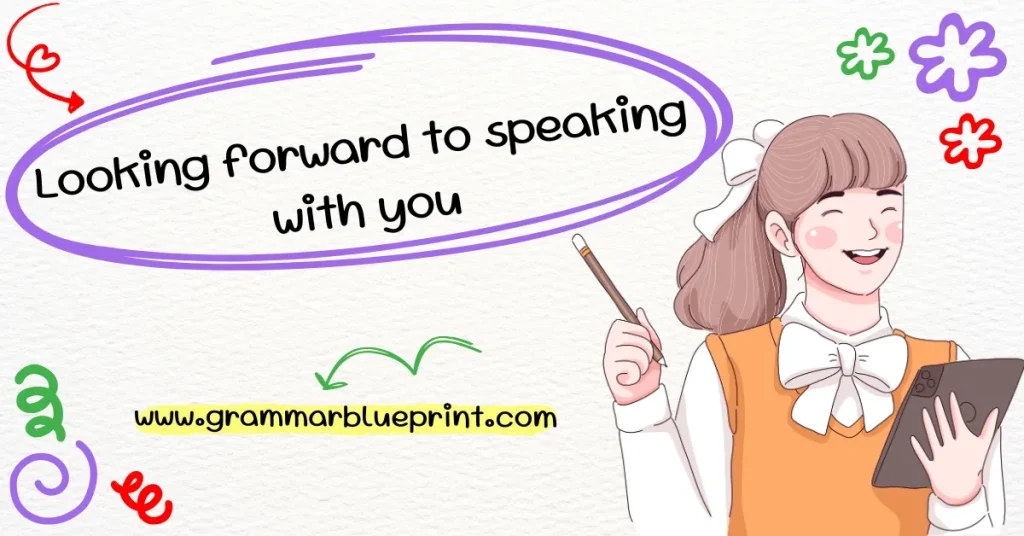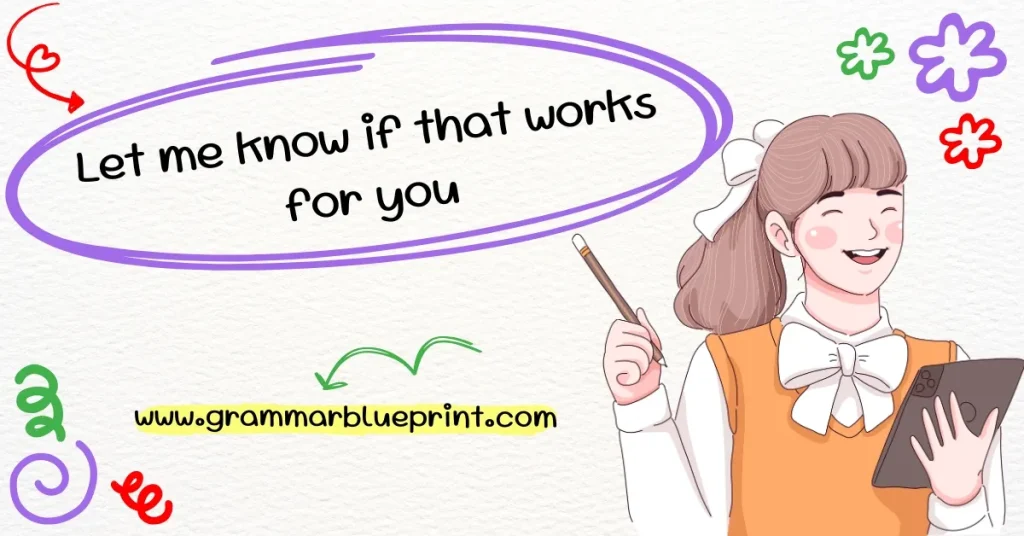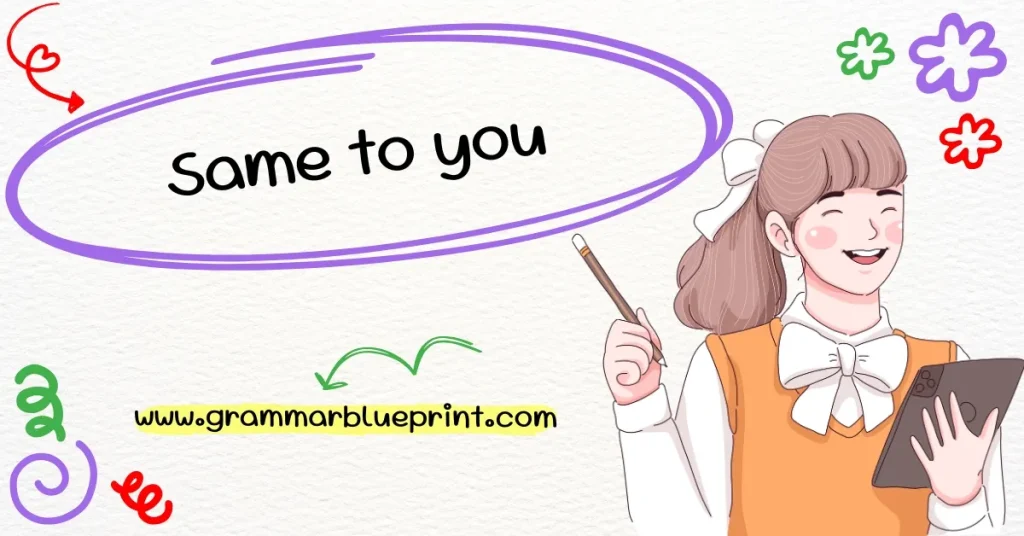The phrase “Looking forward to speaking with you” is commonly used in both professional and casual communication. It expresses eagerness or anticipation for an upcoming conversation or interaction. Mastering this expression can help enhance your English fluency, making your communication sound more polished, polite, and engaging.
What Does “Looking Forward to Speaking with You” Mean?
“Looking forward to speaking with you” is a polite way to express that you are excited or anticipating a future conversation. It is often used to indicate enthusiasm or to make your communication sound more professional. This phrase is versatile and can be used in various contexts, both formal and informal, such as business emails, casual conversations, or networking interactions.
When to Use “Looking Forward to Speaking with You”
Professional Settings
In professional communication, this phrase is a great way to convey eagerness in a respectful, polished manner. Whether you’re confirming a meeting, setting up a call, or expressing excitement about a potential collaboration, “looking forward to speaking with you” shows that you value the conversation.
For example:
- Email: “Thank you for scheduling a meeting. I’m looking forward to speaking with you about the project details.”
- Meeting Confirmation: “I look forward to speaking with you tomorrow at 2 PM.”
Casual Settings
In more casual conversations, the phrase can be used to convey excitement or interest in connecting with a friend or acquaintance. While it still shows eagerness, the tone can be a bit more relaxed.
For example:
- Text Message: “Looking forward to catching up later today!”
- Casual Conversation: “It was nice talking with you earlier. I’m looking forward to speaking with you again soon.”
Benefits of Using “Looking Forward to Speaking with You”
Using “Looking forward to speaking with you” offers several benefits in both personal and professional communication:
Professionalism
In professional communication, using polite expressions such as “Looking forward to speaking with you” enhances your message by making it sound more respectful and courteous. It helps you maintain a positive image while keeping the conversation formal but friendly.
Engagement
This phrase encourages the recipient to respond or engage with you. It shows your enthusiasm and can prompt them to prepare for the upcoming conversation, ensuring they also value the interaction.
Better Alternatives to Say “Looking Forward to Speaking with You”
1. Excited to Speak with You
- Meaning: Shows eagerness and high energy about the conversation.
- Best Use: Casual or enthusiastic conversations with friends, family, or colleagues.
- Tone: Friendly, casual, and warm.
2. Eager to Talk with You
- Meaning: Slightly more formal than “excited,” it conveys readiness to converse.
- Best Use: Professional or semi-formal situations where you want to express enthusiasm.
- Tone: Polite but energetic.
3. Can’t Wait to Chat
- Meaning: Informal and playful, indicating a sense of anticipation.
- Best Use: Informal or social conversations with close friends or colleagues.
- Tone: Relaxed and friendly.
4. Anxious to Have a Conversation with You
- Meaning: Formal and polite, indicating eagerness with a slight emphasis on anticipation.
- Best Use: Professional settings where you want to sound respectful and formal.
- Tone: Polite and formal.
5. Anticipating Our Conversation
- Meaning: A professional and slightly formal expression of looking forward to speaking.
- Best Use: Business meetings or professional emails.
- Tone: Neutral, professional, and respectful.
6. Excited About Our Upcoming Discussion
- Meaning: Emphasizes excitement about an upcoming conversation.
- Best Use: Used in both professional and casual settings when discussing future meetings.
- Tone: Friendly, polite, and enthusiastic.
7. Thrilled to Talk with You
- Meaning: A high-energy and enthusiastic alternative, showing excitement.
- Best Use: Casual conversations or informal meetings where you want to express high anticipation.
- Tone: Energetic, enthusiastic, and positive.
8. Looking Forward to Our Chat
- Meaning: A casual and friendly variation.
- Best Use: Informal settings with friends, colleagues, or family.
- Tone: Light-hearted, friendly.
9. Ready to Speak with You
- Meaning: Indicates that you are prepared and eager for the conversation.
- Best Use: General use in both professional and informal contexts.
- Tone: Neutral, polite, and professional.
10. I’m Eager to Have a Word with You
- Meaning: A polite and somewhat formal way to indicate readiness for conversation.
- Best Use: Used in professional contexts when you want to sound respectful but eager.
- Tone: Polite, formal, and respectful.
11. Awaiting Our Conversation
- Meaning: Indicates that you are eagerly expecting the conversation, with a slight focus on waiting.
- Best Use: Appropriate in both professional and formal communication when you want to express anticipation.
- Tone: Polite, formal, and reserved.
12. Can’t Wait to Hear From You
- Meaning: A casual and eager way of saying that you’re excited for someone’s response or conversation.
- Best Use: Ideal for informal settings like personal emails or conversations with friends.
- Tone: Friendly, casual, and enthusiastic.
13. Looking Forward to Our Talk
- Meaning: A straightforward and neutral way to express excitement about an upcoming conversation.
- Best Use: Suitable for both formal and informal contexts, depending on the relationship with the person.
- Tone: Polite, neutral, and versatile.
14. Enthusiastic About Speaking with You
- Meaning: Strongly conveys eagerness and excitement about the upcoming conversation.
- Best Use: Perfect for enthusiastic business interactions, or when networking and you want to show strong interest.
- Tone: Enthusiastic, energetic, and polite.
15. Anticipating Speaking with You
- Meaning: A formal, polite way to convey that you are looking forward to the conversation.
- Best Use: Best for professional emails or meetings where you wish to sound respectful and courteous.
- Tone: Polite, professional, and somewhat formal.
16. Keen to Talk with You
- Meaning: A more casual, yet still polite, way of expressing your interest and eagerness for the conversation.
- Best Use: Suitable for semi-formal and casual interactions with colleagues or acquaintances.
- Tone: Friendly, informal, and eager.
17. Excited for Our Upcoming Conversation
- Meaning: Conveys a high level of enthusiasm about the conversation, showing eagerness.
- Best Use: Ideal for both formal and informal settings where you wish to express positivity and excitement.
- Tone: Energetic, friendly, and professional.
18. I’m Ready to Chat with You
- Meaning: A relaxed and casual way of expressing that you are prepared for the conversation.
- Best Use: Suitable for informal settings, like casual workplace communications or friendly conversations.
- Tone: Casual, informal, and friendly.
19. I’m Looking Forward to Our Meeting
- Meaning: An expression of eagerness and anticipation for a scheduled meeting or event.
- Best Use: Commonly used in business or professional settings, especially before meetings or events.
- Tone: Formal, polite, and professional.
20. I’m Looking Forward to Our Call
- Meaning: Used to express excitement about a scheduled phone conversation.
- Best Use: Ideal for both formal and informal phone call arrangements, especially in business contexts.
- Tone: Neutral, polite, and professional.
21. It’ll Be Great to Speak with You Soon
- Meaning: Expresses both eagerness and positivity about the upcoming conversation.
- Best Use: Suitable for friendly or semi-formal conversations where you want to show enthusiasm without being too formal.
- Tone: Friendly, positive, and enthusiastic.
22. Can’t Wait to Converse with You
- Meaning: A casual and excited way to express anticipation for the conversation.
- Best Use: Great for informal interactions, especially in social or relaxed settings.
- Tone: Casual, eager, and light-hearted.
23. Looking Forward to Connecting with You
- Meaning: A slightly more professional way of expressing anticipation for a conversation or interaction.
- Best Use: Ideal for networking situations, business meetings, or professional communications.
- Tone: Professional, polite, and respectful.
24. I’m Excited to Speak to You Soon
- Meaning: Expresses high enthusiasm for an upcoming conversation or event.
- Best Use: Used when you want to show eagerness in both formal and informal situations.
- Tone: Friendly, energetic, and polite.
25. Eager to Have a Word with You
- Meaning: A polite, somewhat formal way to express readiness for a conversation.
- Best Use: Suitable for professional settings, particularly when scheduling a meeting or phone call.
- Tone: Polite, respectful, and formal.
26. I’m Anticipating Our Talk
- Meaning: Indicates excitement and readiness, but with a formal touch.
- Best Use: Useful in formal business settings when you want to convey professionalism and anticipation.
- Tone: Formal, professional, and polite.
27. Can’t Wait for Our Discussion
- Meaning: A casual and eager way to express anticipation for an upcoming discussion.
- Best Use: Perfect for informal settings, such as casual business exchanges or friendly interactions.
- Tone: Casual, friendly, and upbeat.
28. Looking Forward to Speaking with You Soon
- Meaning: A polite expression of anticipation, often used when the conversation is scheduled soon.
- Best Use: Suitable for both formal and informal conversations when the event is imminent.
- Tone: Neutral, polite, and professional.
29. I’m Eager to Connect with You
- Meaning: Expresses a willingness and excitement to engage with someone, often used in professional contexts.
- Best Use: Ideal for networking, professional calls, or emails where you want to make a positive impression.
- Tone: Professional, respectful, and polite.
30. I’m Looking Forward to Speaking With You in Person
- Meaning: Indicates a desire to have an in-person conversation, emphasizing personal interaction.
- Best Use: Perfect for professional settings where an in-person meeting is scheduled, or in more casual interactions.
- Tone: Professional, polite, and courteous.
When to Use Each Alternative
Each alternative can be used depending on the tone and context of the conversation:
- Formal Contexts: “Anticipating our conversation” and “Excited about our upcoming discussion” work well in professional settings.
- Casual Conversations: “Can’t wait to chat” and “Looking forward to our chat” are more relaxed and fit well in informal settings.
- Enthusiastic Conversations: “Excited to speak with you” or “Thrilled to talk with you” are perfect for showing eagerness and energy.
- Neutral Contexts: “Ready to speak with you” and “I’m eager to have a word with you” can be used in various situations where you want to convey politeness without being overly formal.
How to Use “Looking Forward to Speaking with You” in Different Contexts
Emails and Letters
When closing a formal or informal email, “Looking forward to speaking with you” is a great way to indicate that you are anticipating a reply or conversation. You can also use variations like “Looking forward to our call” or “Excited to speak with you soon” to adjust the tone depending on the relationship with the recipient.
Phone Calls and Meetings
Before or after scheduling a phone call or meeting, using this phrase can help set a positive tone. You might say something like, “Looking forward to speaking with you during our call tomorrow” or “I’m excited about our upcoming discussion on the project.”
Networking and Interviews
In interviews or networking situations, using this phrase can show enthusiasm and professionalism. For example, “I’m looking forward to speaking with you about this exciting opportunity” or “I’m eager to connect with you during the networking event.”
Common Mistakes with “Looking Forward to Speaking with You”
Grammatical Errors
One common mistake is the incorrect use of prepositions. For example, using “Looking forward to speak with you” instead of “Looking forward to speaking with you” is incorrect. Remember, the phrase “looking forward to” is always followed by the gerund form of the verb (speaking, not speak).
Tone Issues
Another mistake is using “Looking forward to speaking with you” in a context where it might sound too formal or stiff, such as with close friends or family. In these cases, a more casual alternative like “Can’t wait to chat” might be better.
Tips for Non-native Speakers
Pronunciation Tips
When pronouncing the phrase, make sure to emphasize the words “looking forward” and “speaking.” Pronounce each word clearly, especially if you are using this phrase in a professional or formal setting. Focus on the vowel sounds, particularly in the words “looking” and “forward.”
Cultural Considerations
In some cultures, direct expressions of eagerness may be seen as overly enthusiastic. It’s important to be aware of cultural differences when using phrases like “Looking forward to speaking with you.” In more reserved cultures, it might be better to opt for a more neutral phrase like “I look forward to our discussion.”
Conclusion
Mastering the phrase “Looking forward to speaking with you” and its variations is a valuable skill for any English learner. It not only helps you express anticipation and eagerness in conversations but also ensures your communication remains professional, polite, and engaging. By understanding when and how to use these expressions, you’ll improve your overall fluency and confidence in both formal and informal settings.



